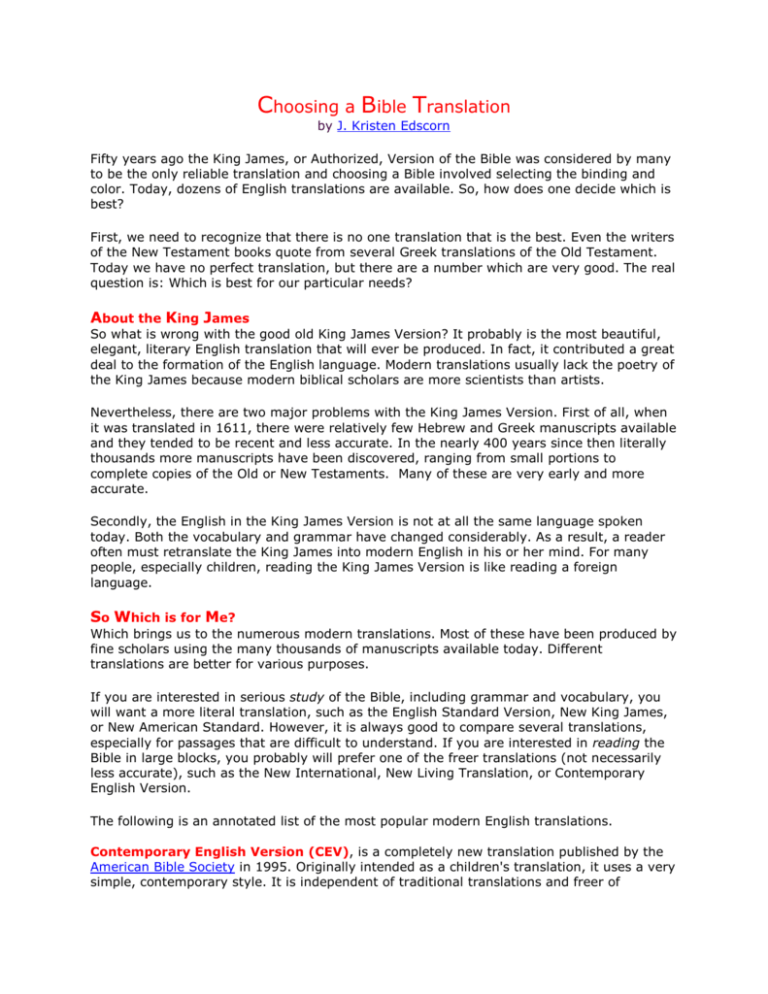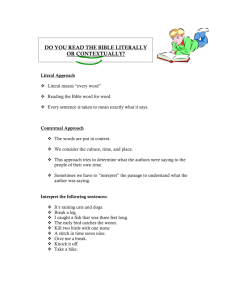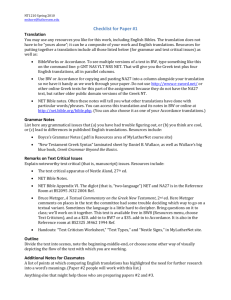Choosing a Bible Translation - Calvary Baptist Church Winchester
advertisement

Choosing a Bible Translation by J. Kristen Edscorn Fifty years ago the King James, or Authorized, Version of the Bible was considered by many to be the only reliable translation and choosing a Bible involved selecting the binding and color. Today, dozens of English translations are available. So, how does one decide which is best? First, we need to recognize that there is no one translation that is the best. Even the writers of the New Testament books quote from several Greek translations of the Old Testament. Today we have no perfect translation, but there are a number which are very good. The real question is: Which is best for our particular needs? About the King James So what is wrong with the good old King James Version? It probably is the most beautiful, elegant, literary English translation that will ever be produced. In fact, it contributed a great deal to the formation of the English language. Modern translations usually lack the poetry of the King James because modern biblical scholars are more scientists than artists. Nevertheless, there are two major problems with the King James Version. First of all, when it was translated in 1611, there were relatively few Hebrew and Greek manuscripts available and they tended to be recent and less accurate. In the nearly 400 years since then literally thousands more manuscripts have been discovered, ranging from small portions to complete copies of the Old or New Testaments. Many of these are very early and more accurate. Secondly, the English in the King James Version is not at all the same language spoken today. Both the vocabulary and grammar have changed considerably. As a result, a reader often must retranslate the King James into modern English in his or her mind. For many people, especially children, reading the King James Version is like reading a foreign language. So Which is for Me? Which brings us to the numerous modern translations. Most of these have been produced by fine scholars using the many thousands of manuscripts available today. Different translations are better for various purposes. If you are interested in serious study of the Bible, including grammar and vocabulary, you will want a more literal translation, such as the English Standard Version, New King James, or New American Standard. However, it is always good to compare several translations, especially for passages that are difficult to understand. If you are interested in reading the Bible in large blocks, you probably will prefer one of the freer translations (not necessarily less accurate), such as the New International, New Living Translation, or Contemporary English Version. The following is an annotated list of the most popular modern English translations. Contemporary English Version (CEV), is a completely new translation published by the American Bible Society in 1995. Originally intended as a children's translation, it uses a very simple, contemporary style. It is independent of traditional translations and freer of "biblical" terms. This is an especially good translation for people who speak English as a second language. English Standard Version (ESV) is an "essentially new literal translation" follows the tradition of the King James, American Standard Version, and Revised Standard Version. Published in 2001 by Crossway, it was developed by a translation team of more than 100 scholars, with the goal of being very accurate (word for word), and yet very readable. Good News Bible (Today's English Version) (TEV), completed in 1976, was translated by Robert G. Bratcher with six other scholars. This very free, though very accurate, translation avoids the use of traditional biblical vocabulary and communicates especially well with youth and the unchurched. Also published by the American Bible Society. Holman Christian Standard Bible (HCSB) is another new word-for-word translation that strives to be both literally accurate and readable. It is not as literal as the ESV or NASB, but is more so than the NIV. The Holman published by Broadman & Holman in 2003, is the product of nearly 100 scholars. The Living Bible (LB), completed in 1971, is Kenneth N. Taylor's paraphrase of the American Standard Version. Easy to read and once immensely popular, it is often criticized for adding too much commentary to the biblical text. Published by Tyndale House, although apparently no longer available from them. The Message (Msg) - Eugene Peterson completed this paraphrase of the entire Bible in 2002. Peterson takes great liberties with words in his attempt to effectively communicate both the original thoughts and tone of the Scripture. The result is a very earthy, informal language. Published by NavPress. New American Standard Bible (NASB) - completed in 1971, was produced by 54 conservative Protestant scholars sponsored by the Lockman Foundation. This version is very literal in vocabulary and word order, although the resulting English is quite wooden. It often is preferred by those who want an English version that reflects the grammar of the original. An Update was published in 1995 which seeks to use more modern English while preserving the literal nature of the translation. New International Version (NIV), completed in 1978, was the product of 115 evangelical scholars. Within a decade it became the best-selling English version. It combines contemporary, literary English with traditional biblical vocabulary. The NIV is copyrighted by the International Bible Society. New King James Version (NKJV), released in 1982, involved 119 contributors. It updates the vocabulary and grammar of the King James Version, while preserving the classic style and beauty. Although it uses the same Hebrew and Greek texts as the original, it indicates where other manuscripts differ. Published by Thomas Nelson. New Jerusalem Bible (NJB) of 1985 revised and updated the text and notes of the Jerusalem Bible of 1966. This version, translated by two Catholic scholars, is an elegant, literary rendering (perhaps the most poetic since the KJV). The notes reflect a modern, liberal perspective. New Living Translation (NLT), published in 1996, is the product of 90 Bible scholars from around the world, from various theological backgrounds and denominations. This is a very readable translation, while remaining more faithful to the original texts than the Living Bible (see above). Also published by Tyndale. New Revised Standard Version (NRSV) - published in 1989 by the National Council of Churches, revises the Revised Standard Version of 1952. While following the literal tradition of the RSV, the NRSV eliminates much of the archaic language. One distinctive is the use of gender inclusive pronouns to replace male pronouns when the original writers meant both men and women. The NRSV does not change masculine pronouns referring to God, however. Revised English Bible (REB), completed in 1989, is a thorough revision of the New English Bible. Like the original, it was translated by a committee of British scholars, representing all the major Christian traditions in the United Kingdom. The more archaic language was omitted and a more conservative approach was taken toward some of the difficult passages. Many readers find it to be an excellent translation for personal reading and study, though its British idioms make it less popular in the U.S. A New Testament of Note Special mention also should be made of an important New Testament paraphrase. A paraphrase translates the thoughts of the original text, not the words. In 1958 J. B. Phillips completed The New Testament in Modern English. Phillips had a special knack of rendering difficult and long sentences into very understandable English. He even translates well some of the Greek puns and word plays that usually are lost. It can be very helpful to have a copy of Phillips nearby, especially when studying the epistles of Paul. For Children Several translations especially for children have been published in recent years, in addition to the CEV mentioned above. The International Children's Bible was completed in 1985 by 21 evangelical scholars. It is written on a high third-grade level. An adult edition, known as the New Century Version, also is available. Published by Thomas Nelson/Word. The International Bible Society produced the New International Reader's Version (NIrV) as a children's version of the popular NIV. It also is on a third-grade reading level. Both of these Children's Bibles are excellent resources for children. The NIrV comes in several study Bible formats designed especially for children. Published by International Bible Society.







